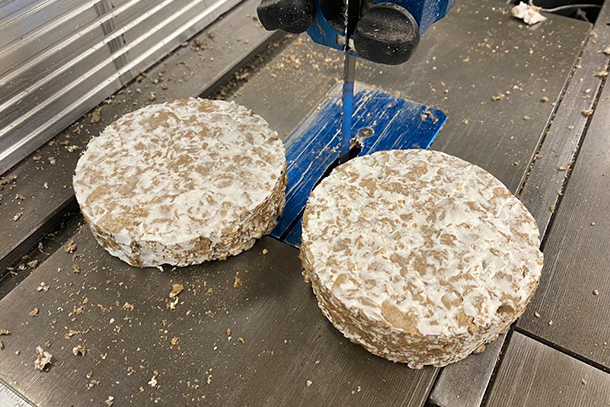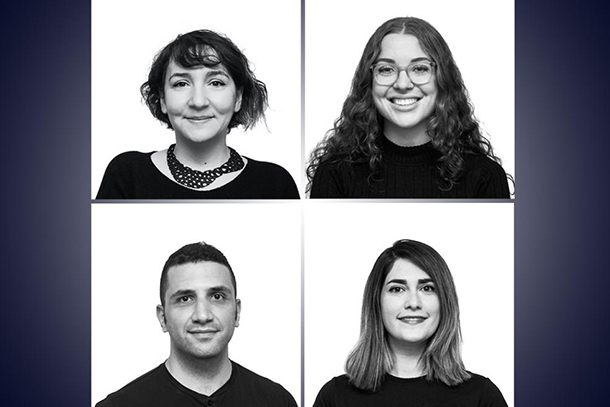
Researchers in the Form and Matter (ForMat) Lab within the Stuckeman Center for Design Computing are cultivating mycelium-based composite samples in the Mushroom Research Center at Penn State to determine their acoustic absorption abilities as well as their mechanical properties to assess their use in building applications. Credit: Natalie Walter/Penn State
New grant looks to biomaterials to help reduce construction waste
December 13, 2022
By Pamela Krewson Wertz
Editor’s Note: This article originally appeared on Penn State News. Nathan Brown, assistant professor of architectural engineering, was mentioned.
UNIVERSITY PARK, Pa. — According to the U.S. Environmental Protection Agency, nearly 600 million tons of construction and demolition debris from man-made polymers and petroleum-based materials were generated in 2018 in the United States. That is more than twice the amount of municipal solid waste generated during that same period. A new grant from the American Institute of Architects (AIA) will allow a Penn State-led research team to study whether fungal biomaterials can replace synthetic acoustic insulation and potentially reduce construction waste.
A team of researchers led by Benay Gürsoy, assistant professor of architecture in the College of Arts and Architecture’s Stuckeman School, have received an AIA Upjohn Research Initiative Grants to study the acoustic absorption properties of mycelium, which is the root-like structure of mushrooms and other fungi, with the goal of designing and building acoustic panel prototypes to be tested in the built environment. The AIA awards up to six such grants annually, providing $15,000 to $30,000 in funding for 18 months.
The project, “Fungal Biomaterials for Sustainable Architectural Acoustics,” builds on work Gürsoy has been leading in her Form and Matter (ForMat) Lab within the Stuckeman Center for Design Computing on fabricating biodegradable building components using mycelium. According to Gürsoy, a growing community of architects is exploring the use of mycelium, which can be grown on a variety of organic waste materials, in architecture.
“Mycelium-based composites are renewable and biodegradable biomaterials that result when mycelium, the vegetative root of fungi, is grown on agricultural plant-based residues,” she said. “These novel biomaterials have the potential to replace conventional petrochemical building materials without relying on the extraction of non-renewable resources. In our research at ForMat, we explore sustainable ways of cultivating mycelium-based building parts and structures.”
Natalie Walter, a second-year master’s degree student who is a co-principal investigator (PI) on the project became interested in Gürsoy’s work with mycelium-based composites while finishing her bachelor of architecture degree at Penn State. She was awarded an Erickson Discovery Grant as an undergraduate architecture student, which she used to explore mycelium-based composites and their relationship to architectural acoustics with Gürsoy.
Walter is cultivating mycelium-based composite samples in the Mushroom Research Center at Penn State to determine their acoustic absorption abilities as well as their mechanical properties to assess their use in building applications.
Penn State faculty researchers Nathan Brown, assistant professor of architectural engineering, and John Pecchia, associate professor of plant pathology and director of the Mushroom Research Center, are co-PIs on the project, as is Linnea Hesse, group leader of the Plant Biomechanics Group at the Botanical Garden at the University of Freiburg. ForMat Lab researchers Ali Ghazvinian, and architecture doctoral candidate, and Alale Mohseni, an architecture master’s degree student, are collaborators.
“Right now, we are investigating if our biomaterials can compare acoustically to conventional acoustic materials by testing them in an impedance tube to gather their absorption coefficients, which we then use to analyze their acoustic performance,” Walter said. “We are also doing mechanical tests to ensure that these materials can physically be used for acoustic panels.”

Clockwise: Benay Gürsoy, principal investigator; Natalie Walter, co-PI; Alale Mohseni, collaborator; Ali Ghazvinian, collaborator. Credit: ForMat Lab/Penn State
Walter said that the team is hoping to gain a more holistic understanding of mycelium-based composites — and biomaterials in general — for use as architectural components.
“We believe that biomaterials can play a huge role in reducing the embodied carbon [the term for the greenhouse gas emissions that arise from the manufacturing, transportation, installation, maintenance and disposal of building materials] and amount of waste generated during material manufacturing,” she said. “So, from a materials standpoint, we hope to contribute new knowledge to this field that can benefit the architectural industry at large.”
Walter also said that the team’s work is novel in the interdisciplinary approach that is being taken.
“This project combines fields of architecture, engineering, mycology and acoustics into one line of research,” she said. “With this approach, we can see different perspectives that we may have been unable to consider with just architectural backgrounds.”
Gürsoy agrees that the approach the team is taking to the project allows for a deeper understanding of this novel biomaterial and its mechanical and acoustic performance.
“We are validating the research by designing, building, testing and learning from full-scale prototypes, alongside computer simulation models and optimization techniques,” she said.
Gürsoy was one of the co-organizers of the Fungal Biomaterials and Biofabrication Workshop at Penn State in May 2022, an event that featured interdisciplinary presentations, panels and discussion groups with the goal of initiating new research collaborations and initiatives of fungal biomaterials.



